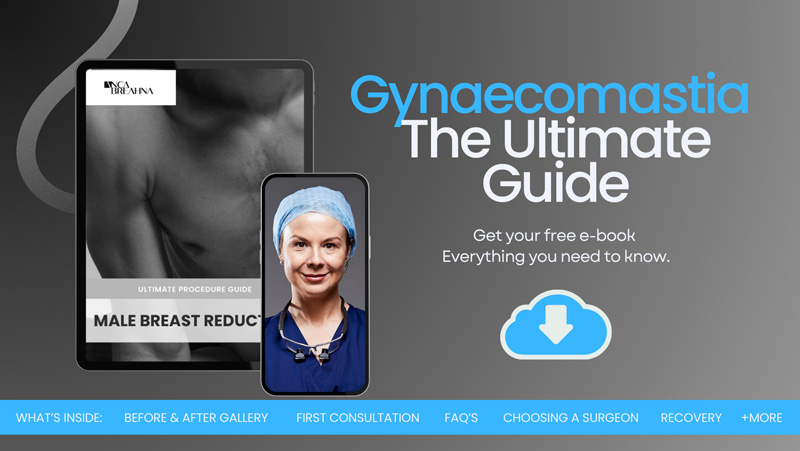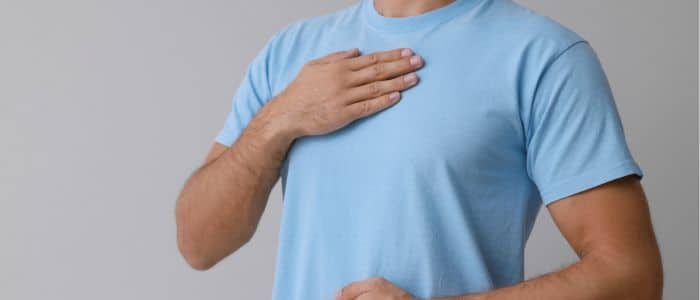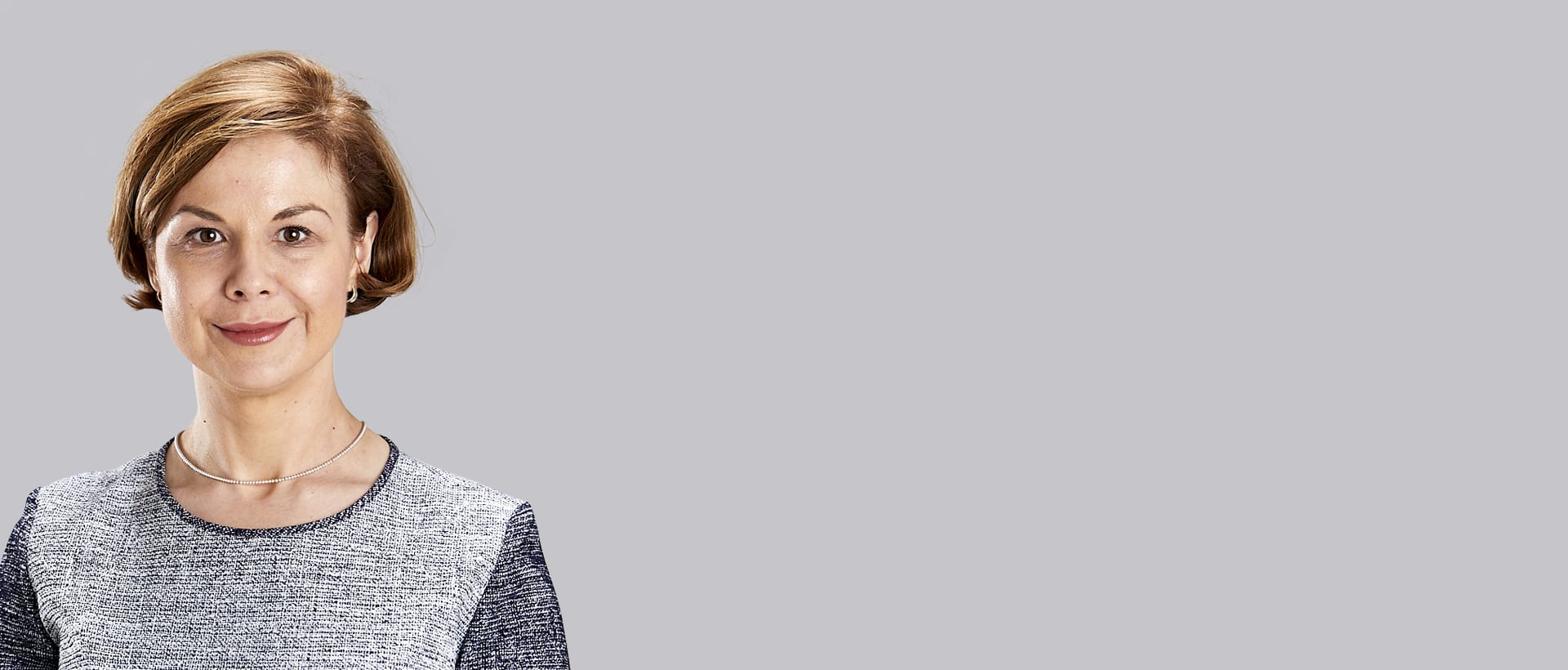
A Guide to Understanding and Overcoming Gynaecomastia
Understanding man boobs, medically known as gynaecomastia, starts with recognising that it’s a common condition affecting a significant portion of men at various stages of life. It involves the enlargement of breast tissues in men or boys, leading to the appearance of breasts which can sometimes cause discomfort or make you feel self-conscious about your appearance. If you are looking for ways to get rid of man boobs, this guide by Anca Breahna, PhD, MSc, FEBOPRAS, FRCS (Plast) is designed to provide clear, straightforward advice to help you make the decisions that are right for you.
Take our Plastic Surgery Quiz to find out if you’d be a good candidate for cosmetic surgery.
What Causes Man Boobs?
At the core of understanding how to manage or reduce man boobs is identifying the causes. Hormonal imbalances play a significant role in this condition. The balance between oestrogen and testosterone can sometimes shift, leading to the development of breast tissue. While oestrogen is more commonly associated with female physical characteristics, men also produce it in smaller quantities. An increase in oestrogen or a decrease in testosterone can result in the growth of breast tissue.
Obesity is another major factor. Excess fat tissue can lead to increased levels of oestrogen, further exacerbating the development of breast tissue. Additionally, fat deposited in the chest area can mimic the appearance of man boobs, even in the absence of true gynaecomastia.
Certain medications and substances can also contribute to this condition. Drugs for heart disease, anti-anxiety medications, antibiotics, and treatments for ulcers, as well as substances like alcohol and anabolic steroids, have been linked to the development of breast tissue in men.
Other underlying health conditions, such as liver or kidney disease, tumours, or genetic disorders, can also lead to hormonal imbalances that promote the growth of breast tissue.
Professional Diagnosis for Enlarged Breasts in Men
If you notice any unexpected swelling, tenderness, or one-sided enlargement in your chest area, it’s wise to book an appointment with Anca. These symptoms can sometimes point to more serious underlying conditions, making an early diagnosis key to effective treatment.
During your visit, anticipate a complete evaluation. Anca will likely inquire about your medical history, any medications you’re taking, and your overall lifestyle habits. A physical examination of the affected area is standard, helping her assess the extent of breast tissue enlargement and rule out other possible conditions, like cysts or masses that could suggest a different treatment approach.
Understanding your diagnosis is very important. Gynaecomastia can be classified into different grades, based on the extent of breast enlargement and whether there’s excess skin. Anca may also suggest tests, such as blood work or imaging studies like ultrasounds or mammograms, to further investigate the cause of your symptoms. This thorough approach ensures that the treatment plan is tailored to your specific situation, addressing the underlying cause and providing clear steps for managing or reducing the condition.
Taking the step to consult with Anca not only brings you closer to finding a solution but also offers peace of mind. Knowing exactly what you’re dealing with can alleviate unnecessary worry and open the door to a variety of treatment options, from lifestyle modifications to potential medical interventions.
Making Lifestyle Changes to Get Rid of Man Boobs
Incorporating healthy lifestyle changes is foundational in managing or reducing man boobs. A well-rounded approach that includes diet, exercise, and overall lifestyle adjustments can significantly impact your physical appearance and how you feel.
· Diet
A balanced diet plays a critical role in weight management and hormonal balance. Focusing on whole foods, such as vegetables, fruits, lean proteins, and whole grains, helps in reducing overall body fat, which can directly influence the size of man boobs. Additionally, limiting intake of processed foods, sugars, and excessive fats is key. These dietary adjustments not only aid in weight loss but also contribute to stabilising hormone levels, potentially reducing breast tissue growth.
· Effective Weight Loss Strategies
Weight loss is often recommended as a first step in reducing man boobs, particularly if obesity is a contributing factor. A sustainable weight loss strategy involves more than just diet; it also includes regular physical activity and possibly consulting with a nutritionist or personal trainer to tailor a plan to your needs. Creating a calorie deficit, where you burn more calories than you consume, is the cornerstone of weight loss. However, it’s important to approach this goal in a healthy, gradual manner to ensure long-term success and avoid negative impacts on your health.
· Regular Exercise
Regular exercise is not only important for weight loss but also for improving muscle tone, which can change the appearance of your chest. A combination of cardiovascular exercises, which help in burning fat, and strength training, specifically targeting the chest muscles, can make a significant difference. Activities like brisk walking, jogging, swimming, and cycling are excellent for overall fat loss, while push-ups, bench presses, and other chest exercises can help in firming the chest area.
Adopting these lifestyle changes requires commitment and patience. Results may not be immediate, but staying consistent with a healthier lifestyle can lead to noticeable improvements over time, not just in the appearance of man boobs but also in your overall health and how you feel day-to-day.
Download our Gynaecomastia Surgery Guide

Medical Treatments and Interventions to Get Rid of Man Boobs
When lifestyle changes and natural approaches don’t lead to the desired improvement in reducing man boobs, medical treatments and interventions may be considered. These options range from medication to surgical procedures, depending on the severity and underlying cause of the condition.
Medication Options
In some cases, medications can be prescribed to address hormonal imbalances contributing to gynaecomastia. These might include:
- Anti-oestrogens are used to treat breast cancer but can also be effective in reducing breast tissue in men.
- Aromatase inhibitors, which reduce oestrogen production, might be considered in specific cases.
It’s important to note that medication is more effective in the early stages of gynaecomastia when the breast tissue is still developing.
Non-Invasive Procedures
For those seeking less invasive options, new treatments like cryolipolysis (fat freezing) may offer a solution by reducing fat cells in the chest area. While not a cure for gynaecomastia, such procedures can improve the chest’s appearance. These options typically require multiple sessions and may not be suitable for everyone, especially if excess glandular tissue rather than fat causes the enlargement.
Surgical Solutions: Gynaecomastia Surgery
Surgery is often considered the most effective treatment for gynaecomastia, especially in cases where there’s a significant amount of glandular tissue or when the condition causes discomfort. The most common procedures include:
- Liposuction, which removes fat but not the breast gland tissue itself.
- Gynaecomastia, a more invasive procedure that removes the glandular tissue.
The choice of procedure depends on your individual case, and a consultation with Anca can provide insights into the best option based on your specific circumstances. Recovery times vary, but most people can return to normal activities within a few weeks, with full physical activities resuming after a few months.
Preparing for Surgery – What You Need to Know
Opting for surgery to address man boobs is a significant decision that requires thorough preparation and understanding of what to expect before, during, and after the procedure.
Criteria for Surgery
Before considering surgery, it’s important to assess whether you’re a good candidate. This includes:
- Being physically healthy and at a stable weight.
- Having realistic expectations about what surgery can achieve.
- Understanding the potential risks and recovery process.
- Having persistent gynaecomastia that has not responded to other treatments.
The Consultation Process
During your consultation, be prepared to discuss your medical history, any medications you’re taking, and your lifestyle habits. Anca will examine your chest, possibly take measurements and photographs, and may recommend additional tests to determine the underlying cause of gynaecomastia.
This is also your opportunity to ask questions. Inquire about the specifics of the recommended procedure, the risks involved, and what recovery will look like. Understanding the scope of the surgery, including potential complications and the expected outcome, will help you make a decision.
Pre-Surgery Checklist
Once you decide to proceed with surgery, you’ll receive instructions to prepare. These may include:
- Adjusting or discontinuing certain medications.
- Stopping smoking, as it can affect healing.
- Arranging for someone to drive you home post-surgery and help during the initial recovery period.
Following these guidelines closely is important for a successful surgery and recovery. Preparing your home for your recovery, such as setting up a comfortable rest area and having necessary supplies on hand, can also make the post-surgery period more manageable.
Man Boobs Surgery Experience from Operation to Recovery
The journey through gynaecomastia surgery, from the operation itself to the recovery period, is a critical phase where understanding and preparation play key roles. Here’s an overview of what to expect:
What Happens During Surgery
Gynaecomastia surgery is performed under general anaesthesia, meaning you will be asleep during the procedure. The surgery can take 1 to 3 hours, depending on the extent of the correction needed. There are two main surgical techniques used:
- Liposuction is employed to remove excess fat from the chest area. Anca makes small incisions and uses a tube to suction out fat.
- Mastectomy, or the removal of glandular tissue, may be necessary for more severe cases. This involves larger incisions and a more involved recovery process.
In some instances, a combination of both techniques is used to achieve the best results. The goal is to create a chest that is flatter, firmer, and better contoured.
Post-Surgery: Recovery and Care
Immediately following the surgery, you’ll be taken to a recovery area where your condition and vital signs will be monitored as you awaken from anaesthesia. You may experience soreness, swelling, and bruising, which are normal. Drainage tubes may be placed to remove excess fluid, and you’ll likely be wrapped in a compression garment to minimise swelling and support the chest as it heals.
Recovery times vary, but most people can return home the same day. It’s essential to have someone available to drive you and stay with you for at least the first night. Recovery instructions provided by Anca may include:
- Care for the surgical site and drains.
- Medications to apply or take orally to aid healing and reduce the risk of infection.
- Specific concerns to look out for at the surgical site or in your general health.
FAQs about Man Boobs
Can man boobs go away on their own?
- In some cases, man boobs, especially if caused by puberty or minor weight fluctuations, can recede over time without the need for intervention. This is more common in younger individuals where hormonal imbalances may correct themselves as they grow older. However, for many, especially if the condition is linked to obesity or long-standing hormonal imbalances, lifestyle changes or medical treatments may be necessary to see improvement.
Are there any specific foods that can cause or worsen man boobs?
- While no single food causes man boobs, a diet high in processed foods, unhealthy fats, and sugars can lead to weight gain and obesity, which can exacerbate the condition. Additionally, excessive alcohol consumption and foods with high levels of phytoestrogen (like soy products) might contribute to hormonal imbalances, potentially affecting breast tissue growth.
How long does it take to see results from exercise in reducing man boobs?
- The time it takes to see results from exercise can vary widely based on individual factors such as starting weight, overall health, and consistency with exercise. Typically, noticeable improvements can take several months of consistent cardiovascular and strength training. It’s important to set realistic expectations and focus on overall health rather than quick fixes.
Can supplements help reduce man boobs?
- Some supplements claim to balance hormones or reduce fat, but there’s limited scientific evidence to support the effectiveness of most supplements in specifically reducing man boobs. Before taking any supplements, it’s crucial to consult with a healthcare professional, as some products may have side effects or interfere with other medications.
What is the difference between gynaecomastia and chest fat?
- Gynaecomastia is the enlargement of breast tissue in men, often linked to hormonal imbalances, and can occur even in individuals who are not overweight. Chest fat, or pseudo gynaecomastia, refers to the accumulation of fat in the chest area, which is more directly related to overall body fat levels. Distinguishing between the two typically requires a medical evaluation, as the treatment approach may differ.
Further Reading about Men Surgery with Chester Consultant Plastic Surgeon Anca Breahna
- Read more about UK’s Most Popular Plastic Surgery for Men
- Read more about How to Get Rid of Puffy Nipples in Men
- Read more about Recovery after Gynaecomastia Surgery
- Read more about When Can I Exercise after Gynaecomastia
- Read more about How to Get Rid of Old Scars
- Read more about How to Get Rid of Moles
- Read more about What Are Gynaecomastia Surgery Scars Like?
Medical References about Man Boobs
- Gynaecomastia – NCBI
- Gynaecomastia: Etiology, Diagnosis, and Treatment – NCBI
- Enlarged breasts in men – Mayo Clinic
- How to get rid of man boobs: Exercise, diet, and treatment – Medical News Today
- Enlarged Male Breast Tissue (Gynaecomastia) – Cleveland Clinic



 Ms Anca Breahna, PhD, MSc, FEBOPRAS, FRCS (Plast) is a highly regarded Consultant Plastic Surgeon specialising in the field of Aesthetic and Reconstructive Plastic Surgery. Anca performs a range of
Ms Anca Breahna, PhD, MSc, FEBOPRAS, FRCS (Plast) is a highly regarded Consultant Plastic Surgeon specialising in the field of Aesthetic and Reconstructive Plastic Surgery. Anca performs a range of 